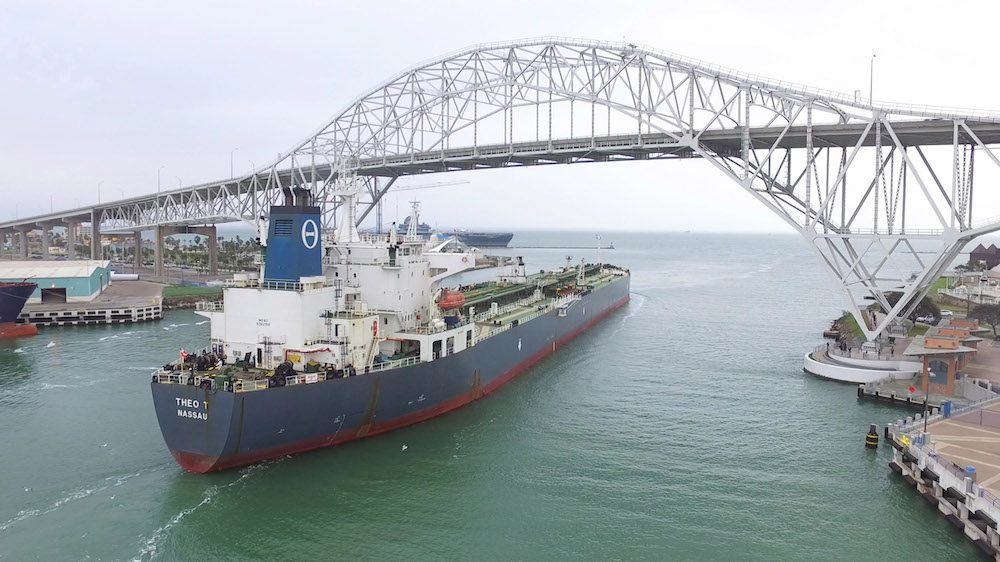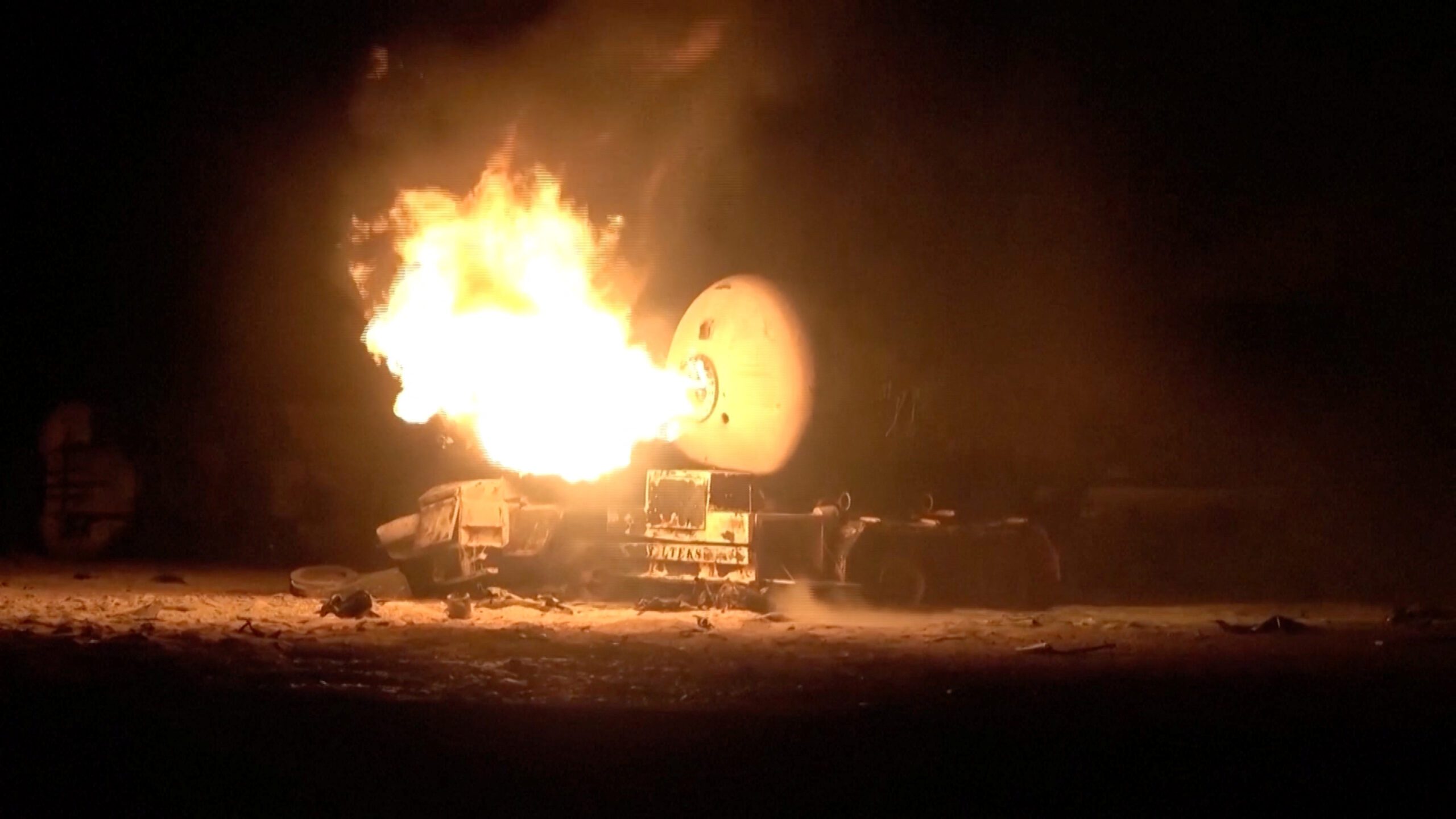The Theo T departs Corpus Christi on Dec. 31 with the first US crude export shipment since the United States government repealed a 40 year ban on the export of crude oil in December. Photo credit: Port of Corpus Christi
By Joe Carroll and Harry R. Weber
(Bloomberg) — The sea stretched toward the horizon last New Year’s Eve as the Theo T, a red-and-white tug at her side, slipped quietly beneath the Corpus Christi Harbor Bridge in Texas. Few Americans knew she was sailing into history.
Inside the Panamax oil tanker was a cargo that some on Capitol Hill had dubbed “Liquid American Freedom” — the first U.S. crude bound for overseas markets after Congress lifted the 40-year export ban.
It was a landmark moment for the beleaguered energy industry and one heavy with both symbolism and economic implications. The Theo T was ushering in a new era as it left the U.S. Gulf Coast bound for France.
The implications — both financial and political — for energy behemoths such as Saudi Arabia and Russia are staggering, according to Mark Mills, a senior fellow at the Manhattan Institute think tank and a former venture capitalist. “It’s a game changer,” he said.
For the Saudis and their OPEC cohorts, who collectively control 40 percent of the globe’s oil supply, the specter of U.S. crude landing at European and Asian refineries further weakens their grip on world petroleum prices at a time they are already suffering from lower prices and stiffened competition. With Russia also seeing its influence over European energy buyers lessened, the two crude superpowers last week tentatively agreed to freeze oil output at near-record levels, the first such coordination in a decade and a half.
Geopolitical Fallout
The political effects need not wait until U.S. shipments become more plentiful, Mills said. “In geopolitics, psychology matters as much as actual transactions,” he said.
Meanwhile, the U.S. is also poised to make its first shipments of liquefied natural gas, or LNG, from shale onto world markets within weeks, about two months later than scheduled. Cheniere Energy Inc. expects to have about 9 million metric tons a year of LNG available for its own portfolio from nine liquefaction trains being developed at two complexes in Texas. That’s enough to power Norway and Denmark combined for a year.
The immediate beneficiaries of this renewed era of U.S. exports are gas and oil companies such as Continental Resources Inc., Chevron Corp. and Exxon Mobil Corp. that have lobbied vigorously in recent years against the 1975 ban, which blocked all but a fraction of oil movements. It was imposed in the aftermath of a 1973-74 OPEC oil embargo, which crippled the U.S. economy and brought home the heavy dependence the country had developed on foreign suppliers.
U.S. Gains
Beyond corporations, the Dec. 18 lifting of the export ban by Congress and President Barack Obama created geopolitical winners and losers, too. The U.S., awash in shale oil, has gained while powerful exporters like Russia and Saudi Arabia, for whom oil represents not just profits but also power, find themselves on the downswing.
The U.S. remains a net importer, but its demand for foreign oil has fallen by 32 percent since peaking in 2005. West Texas Intermediate crude traded at $33.34 a barrel at 8:51 a.m. on the New York Mercantile Exchange Tuesday, down 33 percent from a year earlier.
Meanwhile, plummeting oil and gas prices, driven in part by the U.S. shale revolution, have already eroded OPEC and Russia’s abilities to use natural resources as foreign policy cudgels. They are also squeezing petroleum-rich economies from Venezuela to Nigeria that rely heavily on crude receipts to fund everything from military budgets to fuel subsidies.
“A prolonged period of low gas and oil prices will put heavy pressure on Russia in its relations with the West and of course low energy prices put tremendous strain on all exporters of hydrocarbons worldwide, on their government budgets,” said Ted Michael, an analyst at Genscape Inc., an energy-market data and intelligence firm.
Second Vessel
The Theo T was joined shortly after its trailblazing journey by a second ship out of Houston destined for the Netherlands. How many tankers have sailed since won’t be known until comprehensive data on January’s shipments is released by the U.S. Census Bureau in the coming weeks.
Trafigura Group Pte Ltd. also sold West Texas Intermediate oil to a refinery in Israel, Ben Luckock, global head of crude oil at the commodity trader, said on Monday by e-mail. The 700,000-barrel cargo of U.S. benchmark crude will be delivered in March.
What’s already clear is that even with crude losing about 70 percent of its value since the middle of 2014 amid a worldwide production glut and a slowdown in Chinese demand growth, buyers are happy for the chance to diversify their sources of supply.
The U.S.
“If you’re a buyer in, say, South Korea, and you’re offered the same price from Saudi Arabia, Russia and the U.S., you’re going to make the obvious choice: the U.S.,” Mills said. “It’s the one supplier you know is never going to threaten you or cut off supplies, which is certainly not the case with Saudi Arabia, Russia or Iran.”
A similar story is beginning to unfold in natural gas, where U.S. production also has multiplied in recent years as a result of advances in shale extraction.
U.S. companies, led by Cheniere, have been spending billions of dollars on LNG export complexes where the fuel is cooled to minus 256 degrees Fahrenheit (minus 160 Celsius) to shrink it to 1/600th its volume so it can be shipped aboard ocean-going tankers. As a result, an international gas market is emerging akin to the long-established one for the more readily transportable crude oil.
LNG Exports
Houston-based Cheniere plans to begin LNG exports within weeks, after missing a January target because of faulty wiring. The first tanker that will carry LNG from Cheniere’s Sabine Pass terminal in Louisiana has arrived. Asia Vision has moored at Sabine Pass, according to ship-tracking data compiled by Bloomberg.
U.S. LNG cargoes, in combination with a bevy of new gas projects in Australia, will probably add 15 billion cubic feet of daily supply to global markets in the next few years, Genscape’s Michael said. That would be a 43 percent addition to the 35 billion currently bought and sold internationally.
“We will definitely replace Russia as the lowest-cost supplier,” Fadel Gheit, an analyst at Oppenheimer & Co., said of the U.S. expansion. “All of these things will have geopolitical and economic consequences. It’s a win-win for the U.S. and the West.”
© 2016 Bloomberg L.P

 Join The Club
Join The Club










